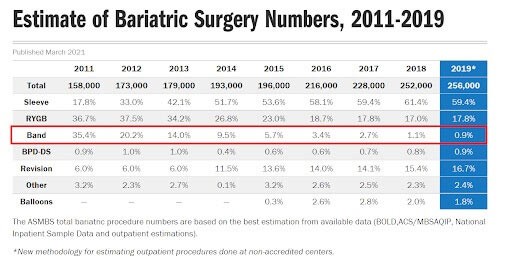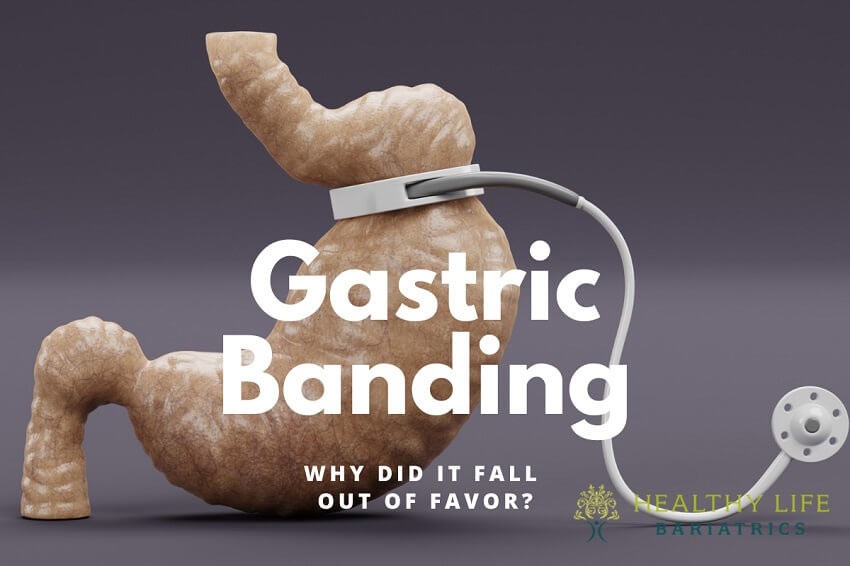Gastric banding, which is otherwise referred to as a Lap-Band, is a procedure aimed at helping morbidly obese patients lose weight.
Gastric band surgery has existed in some form or another since the 1970s. In the eighties, the surgery took the form we all know today, laparoscopic adjustable gastric banding.
In the 90s and early 2000s, the Lap-Band became the most popular weight loss procedure for patients who had tried everything to drop unwanted pounds but to no avail.
It wasn’t until 2008 that the Lap-Band saw a decline in popularity. This was due to the fact that many patients began reporting complications and limited weight loss following the surgery.
If you are still wondering if the Lap-Band is right for you, keep reading. You will soon learn the specifics of the procedure, how it helps with weight loss, and whether it’s still a viable solution for helping you lose weight when you have become morbidly obese.
What is Lap-Band Surgery?
Laparoscopic adjustable gastric banding (LAGB) is a procedure that helps you lose weight by restricting your food intake. The surgeon does this surgery laparoscopically. Small incisions function as entry points for serpentine tools, including a camera, allowing the surgeon to perform the technique while watching the action on a monitor in the operating room. This makes the procedure less invasive than “open” surgeries.
During the procedure, a silicone band lined with an inflatable balloon is placed under the skin of the abdomen. The band is then placed around the stomach, effectively separating the top of the stomach from the bottom portion. The inflatable balloon allows the surgeon to tighten the band, which restricts the amount of food you can eat.
There are several types of adjustable banding. The one most people are familiar with is the Lap-Band system. The Lap-Band is also the one that received FDA approval in 2001.
At the time gastric banding became popular, the alternative bariatric surgery was the intestinal bypass, which adjusts the digestive system to aid in weight loss. The Lap-Band didn’t involve any alteration of the internal organs and thus was considered a safe alternative with minimal risk of complications.
Excess weight loss proved to be lower with gastric banding than with gastric bypass surgery, with patients losing 50% of excess weight on average versus 70% excess weight loss with the gastric bypass. Still, patients appreciated that the Lap-Band helped with weight loss and weight-related comorbidities and was reversible to boot.
Facts About Lap-Band You May Not Know
Now that you know more about this once popular bariatric surgery, let’s find out why the Lap-Band has fallen out of favor.
Fewer People are Opting for Lap Band Surgery
Less than 1% of bariatric patients underwent the gastric band procedure in 2019. That’s a sharp decline from Lap-Band’s popularity of 35% in 2011.

Source: https://asmbs.org/resources/estimate-of-bariatric-surgery-numbers
Laparoscopic Banding Isn’t as Effective as Other Weight Loss Surgeries
Bariatric surgeons have chosen other procedures ahead of the gastric band for their patients because studies show those alternatives are more effective for long-term weight loss.
While short-term results can be achieved with the Lap-Band, it’s over time that patients can experience weight gain and other complications.
Why Do Some Lap-Band Patients Gain Weight?
The restrictive aspect of laparoscopic gastric banding doesn’t work for everyone. Some fattening foods can still be eaten in massive quantities, even with the Lap-Band in place. Examples include ice cream and liquids like milkshakes. If you enjoy high-calorie beverages and ice cream, and you eat small meals all day long, you may not lose weight following a gastric banding procedure. In fact, you may gain weight.
What Are Potential Complications of Gastric Banding?
While initially the Lap-Band is considered a bariatric procedure with minimal risk of complications, the risks increase over time. Studies show that there is a 3% to 4% increased risk of complications for each year the Lap-Band is left in place.
These complications include:
Band Erosion
This is where the silicone band erodes through the outer stomach into the inside portion of the stomach. This can cause hunger and potential infection.
Band Intolerance
Because the Lap-Band is a foreign object, your body may reject it. Excessive scar tissue, nausea, vomiting, and acid reflux can result.
Gastric Band Slippage

The Lap-Band can slip down on the stomach, resulting in vomiting, stomach perforation, and acid reflux.
Food Trapping
Pieces of food can become caught in the narrowed stomach opening being constricted by the band. This can cause digestive problems and vomiting.
Esophageal Dilation
The esophagus can enlarge in the years following the Lap-Band procedure. When this happens, the esophagus can lose normal function, preventing food from being pushed down into the stomach. This can lead to swallowing problems, heartburn, acid reflux, and vomiting.
Pouch Dilation
The stomach can stretch above the band, leading to uncontrollable hunger and weight regain.
Band Leakage
The inner balloon portion of the Lap-Band can break down and leak saline solution, which is used to inflate the balloon during the LAGB procedure. The band can then loosen, leaving you feeling hungry beyond control. Weight regain can result.
Reoperation is Sometimes Necessary with Gastric Banding
Between 15% and 60% of patients with the Lap-Band require follow-up surgery.
Many patients have the Lap-Band removed because it slips, deteriorates or other complications occur. Others choose to have the band removed because of the strict diet they are forced to stay on, the lack of weight loss results, or potentially painful side effects including constipation, bowel perforations, nausea, and vomiting.
What are the Costs for Lap Band Surgery and Lap-Band Removal?
The average cost of laparoscopic adjustable gastric banding is around $15,000 but can cost as much as $30,000, depending on where you go, and which surgeon you choose to perform the surgery.
Read our article: Find the Best Bariatric Surgeon for Assured Weight Loss in Los Angeles, CA
If there are complications and you want the band removed, you’ll have to spend as much or potentially more for the reoperation.
Between the years 2006 and 2014, $820 million of the $2.1 billion spent on Lap-Band procedures were reserved for follow-up operations. Most recently, around 90% of the total spending on gastric banding was for reoperations because of the lack of weight loss or complications.
Insurance may pay for the procedure, depending on your policy coverage. Some insurance policies will only pay for one Lap-Band surgery, which means they won’t cover Lap-Band removal.
Keep in mind that Lap-Band systems do not last forever. Many patients have them removed within ten years or less.
What Weight Loss Surgeries are More Effective Than the Lap-Band?
Since the Lap-Band started falling out of favor, two other bariatric surgeries stepped into the spotlight. Gastric bypass has become the gold standard of bariatric surgery. However, the gastric sleeve is quickly becoming the most popular weight loss surgery the world over.
Both the Roux-en-Y gastric bypass and laparoscopic sleeve gastrectomy (LSG) are considered safer and more effective than LAGB surgery.
How Does Gastric Bypass Surgery Compare to the Lap-Band?
There are a few similarities between gastric bypass surgery and LAGB surgery. Both procedures limit how much you can eat and make you feel fuller faster during meals.
There are also differences between the two surgeries. While the Lap-Band is temporary and reversible, the Roux-en-Y gastric bypass is permanent.
During the gastric bypass, which is performed laparoscopically similar to the LAGB procedure, the surgeon removes 80% of the stomach. The remaining stomach tissue is converted into a banana-sized pouch. That pouch is where the food you eat will pass on its way to digestion.
Because the stomach is smaller, you eat less and feel satiated much faster when eating.
The surgeon then connects the smaller stomach pouch to a portion of your intestine. Because of this alteration, your body absorbs fewer calories from the foods you eat.
Because of the permanence and changes to your digestive system, gastric bypass surgery results in faster and longer-term weight loss than LAGB surgery.
You will have to do your part by eating sensibly and by engaging in a regular exercise program, which your bariatric surgeon can advise you on as part of your bariatric surgery treatment plan.
Gastric Bypass Risks
Gastric bypass surgery does come with risks. However, the surgery is considered less risky than the Lap-Band because of that procedure’s propensity for causing problems.
Potential risks of gastric bypass surgery include dumping syndrome, which is a condition that can cause nausea and dizziness, as well as low blood sugar, malnutrition, ulcers, hernias, and bowel obstruction.
Because your body may absorb fewer minerals after gastric bypass surgery, your surgeon may advise you to take a regular multivitamin and other supplements.
The lower body mass index (BMI) you have prior to having gastric bypass surgery, the lower the chances of risks and side effects.
Gastric bypass surgery costs around $23,000. Insurance may pay for the procedure, depending on the specifics of your policy.
Read our article: How Gastric Bypass Surgery Makes Weight Loss Easier
How is the Sleeve Gastrectomy Different from Gastric Banding?

Gastric sleeve or laparoscopic sleeve gastrectomy (LSG) also involves the removal of 80% of your stomach. The smaller, banana-shaped sleeve that is converted from the remaining stomach tissue limits how much you can eat. The difference between the gastric sleeve and gastric bypass is that there is no diverting to the intestines. It only affects your stomach.
After gastric sleeve surgery, you eat less and feel less hungry overall. This is on account of certain hormonal changes that occur because of the surgery which helps to regulate hunger, fullness, and blood sugar.
Read our article: Does Gastric Sleeve Affect Hormones?
You stand to lose around 50% of your excess weight over the long term with the help of the gastric sleeve.
Like gastric bypass surgery, you are encouraged to follow a healthy lifestyle and regular fitness regimen after gastric sleeve surgery, which can lead to faster, more substantial, and longer-term weight loss.
Gastric sleeve costs around $14,900 with insurance likely to provide coverage, if your policy includes bariatric surgery.
Read our article: Gastric Sleeve Insurance and How to Afford Surgery Without Coverage
Read our article: Bariatric Surgeon Answers: Can You Convert the Lap-Band to a Gastric Sleeve?
Want to Lose Weight Safely and Effectively? Schedule a Consultation Today
As you can see, the laparoscopic gastric banding procedure is no longer considered the most popular bariatric surgery for a host of reasons. Not only does it potentially lead to weight regain after a few years, but the chances of complications are high for every year the Lap-Band stays in your body.
You also need to remove Lap-Bands at some point. That makes reoperations likely and expensive, with insurance unlikely to cover the total costs.
You can’t lose all hope if you are morbidly obese, however. Both the gastric bypass procedure and gastric sleeve are viable alternatives to the Lap-Band. You stand to lose more than half or more of your excess weight and both procedures treat obesity comorbidities like type 2 diabetes, high blood pressure, obstructive sleep apnea, and many more.
If you would like to know if you are a suitable candidate for either the Roux-en-Y gastric bypass or the laparoscopic gastric sleeve, call Healthy Life Bariatrics to schedule a consultation.
During your discrete consultation with Dr. Babak Moeinolmolki, you can learn more about the specifics of bariatric surgery, the benefits, risks, as well as fees, insurance, and medical financing. Contact us now in Los Angeles or ask about our medical tourism program for those living outside of Southern California. You can reach our friendly staff by dialing 310-807-2378.





